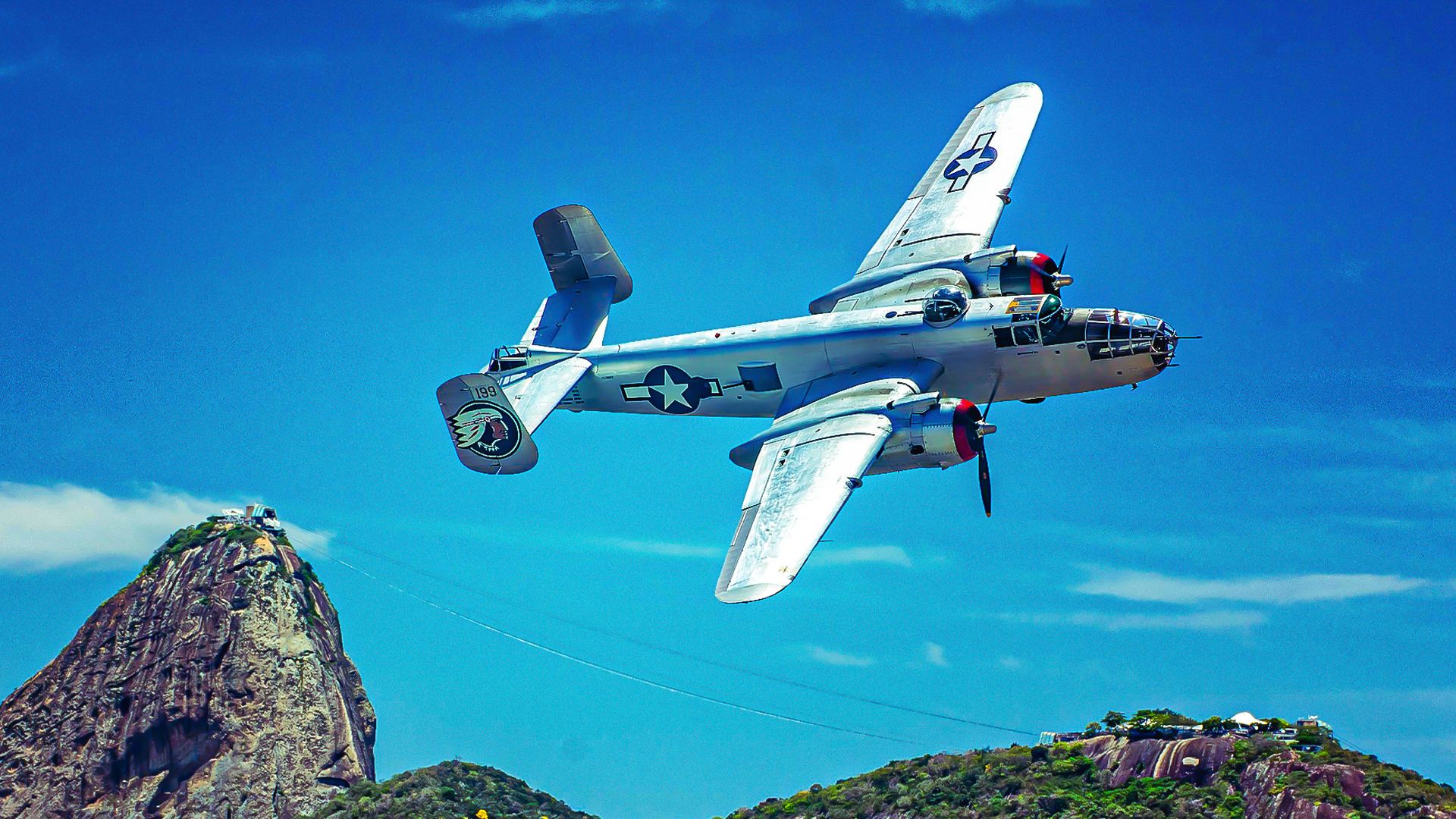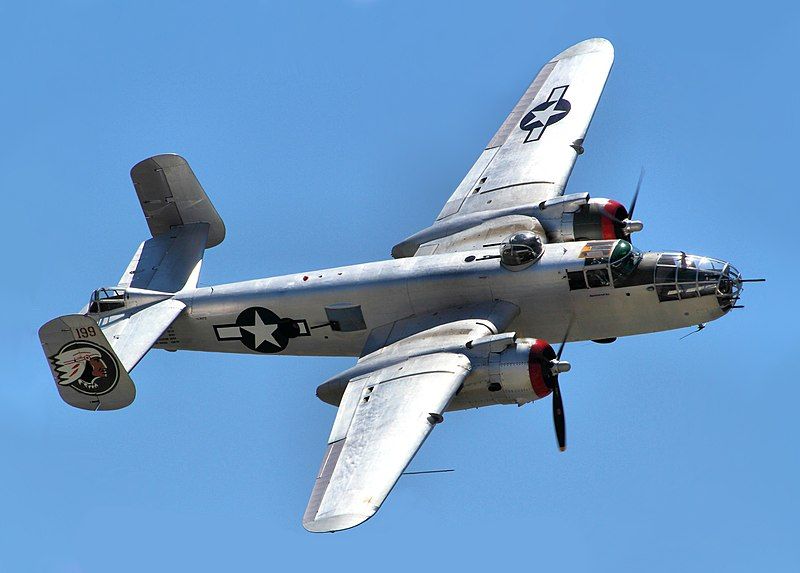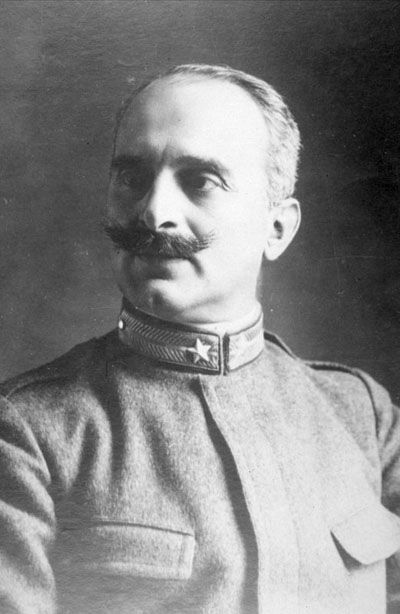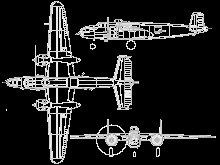Summary
- The B-25 Mitchell bomber was versatile in combat due to flexibility: ready to adapt to different requirements.
- The B-25 made its maiden flight in 1940, entered operation in time for Pearl Harbor, known for Doolittle Raid versatility.
- The B-25 was widely used by the USAAF in the Pacific Theatre for gunship duty and skip-bombing, and showed adaptability.
Next to Boeing’s B-17 Flying Fortress and B-29 Superfortress heavy bombers, the North American B-25 Mitchell medium bomber is arguably the most famous American bomber of the Second World War. (With all due love and respect to the Consolidated B-24 Liberator heavy bomber, of course.)
Of course, the B-25’s biggest claim to fame was its use in the immortal Doolittle Raid on Tokyo on April 18, 1942, as dramatized by the 1944 film Thirty Seconds Over Tokyo, starring the late great Spencer Bonaventure Tracy (April 5, 1900 – June 10, 1967) as the equally late great Lieutenant Colonel (later honorary four-star General) James Harold Doolittle (December 14, 1896 – September 27, 1993).
But that Tokyo raid was far from the only reason the B-25 was deservedly famous. Simple Flying now examines what made the Mitchell such a wonderfully versatile warbird.
Flexibility and versatility: closely intertwined
Before we discuss the B-25’s versatility, let’s talk semantics for a wee bit, shall we?
“Flexibility is the key to airpower.”
–General Giulio Douhet (30 May 1869 – 15 February 1930)
Yes, I realize that I’ve recycled that quote ad nauseam, but seeing how it remains a key tenet of the present-day US Air Force, it bears repeating here. “Flexibility” and “versatility” aren’t completely synonymous, but they’re definitely intertwined. Merriam-Webster’s defines the two words as follows:
- flexibility: characterized by a ready capability to adapt to new, different, or changing requirements
- versatility: the quality or state of being versatile (which in turn is defined as “having many uses or applications”)
That said, let’s move on to the topic at hand, shall we?
B-25 Mitchell early history and specifications
The North American B-25 Mitchell made its maiden flight on August 19, 1940, and, as Lady Luck/Fate/Destiny/Karma/Joss would have it, officially went into operational service in mid-1941, i.e., just in time for the Pearl Harbor raid and America’s entry into WWII.
The now-defunct (effective March 1967) North American Aviation (NAA) is, of course, also renowned for producing the legendary P-51 Mustang fighter plane.
The B-25 (specifically the B-25H variant) had the following specifications:
|
Crew: |
5 (one pilot, navigator/bombardier, turret gunner/engineer, radio operator/waist gunner, tail gunner) |
|
Fuselage Length: |
52 ft 11 in (16.13 m) |
|
Wingspan: |
67 ft 7 in (20.60 m) |
|
Height: |
16 ft 4 in (4.98 m) |
|
Empty Weight: |
19,480 lb (8,836 kg) |
|
Max Takeoff Weight: |
35,000 lb (15,876 kg) |
|
Powerplant: |
2 × Wright R-2600-92 Twin Cyclone 14-cylinder two-row air-cooled radial piston engines, 1,700 hp (1,300 kW) each |
|
Max Airspeed: |
272 mph (438 km/h, 236 kn) at 13,000 ft (4,000 m) |
|
Cruise Speed: |
230 mph (370 km/h, 200 kn) |
|
Range: |
1,350 mi (2,170 km, 1,170 NM) |
|
Service Ceiling: |
24,200 ft (7,400 m) |
|
Armament: |
|
The USMC PBJ variant (more on this a bit), because it performed most of its missions at low altitude, eliminated the glass nose/bombardier position and replaced it with a solid nose armed with up to 8 – .50 caliber machine guns, or in some versions, a 75 mm cannon.
Operational performance in the Pacific Theatre
As I mentioned in the previous section, the B-25 entered operational service just in time for America’s entry into WWII, and that timing proved to be quite fortuitous, and not just because of the timing of the aforementioned Doolittle Raid either: a Mitchell flown by the US Army Air Forces (USAAF) 17th Bombardment Group struck one of the earliest retaliatory blows at Hideki Tojo and the mikado by sinking an Imperial Japanese Navy (IJN) submarine on Christmas Eve of 1941.
As for that Tokyo raid, it was a level bombing mission that inflicted little physical damage (50 Japanese killed, 400 injured, five patrol boats sunk, and the IJN aircraft carrier Ryūhō [龍鳳, “Dragon Phoenix”] damaged), but the boost to American morale (civilian and military alike) was astronomical.
The two most effective missions for USAAF B-25s operating in the Pacific Theatre of Operations were:
- Gunship duty
- Skip-bombing
Yes, the Mitchell preceded the Vietnam War-era AC-47 “Spooky” (AKA “Puff the Magic Dragon”) in fixed-wing gunship duties by a good solid two decades. The warbird’s pilots could indeed use that 75mm gun to devastating effect; one B-25 crew sank an IJN destroyer with a mere seven hits! However, the Mitchell drivers generally preferred the machine guns to the slow-firing cannon for strafing purposes, especially against airfields.
As for skip-bombing, this practice was simply devastating to Axis shipping on the receiving end of such attacks; the tactic entailed literally skimming bombs like stones across ocean wave tops and then burrowing into the sides of the vessels’ hulls as they exploded, thus functioning much like a torpedo. In one particularly noteworthy instance, a dozen Mitchells from the 3rd Bombardment Group employed the skip-bombing technique to sink four cargo vessels and two destroyers in the first 15 minutes of their first combat mission (more than mere beginner’s luck, eh)!
Operational performance in the European/North African/Mediterranean Theatres
As for the fight against Imperial Japan’s erstwhile Axis allies (paradoxical pun intended) in the opposite Hemisphere, i.e., Adolf Hitler’s Nazi Germany and Benito Mussolini’s (“il Duce“) Fascist Italy, the USAAF observed that the faster B-26 Marauder was more suitable for operations in Continental Europe, so they operated the B-25 mainly in the Mediterranean. Therein, just as in the Pacific, the Mitchell proved quite adept at antisubmarine warfare (ASW) duty; indeed, that aforementioned 17th BG would later transfer to the Atlantic and sink a Kriegsmarine Unterseeboot (U-boat) for good measure.
However, the B-25 wasn’t completely ignored in the fight to liberate Western Europe, as it was used on at least one occasion to destroy a significant number of Luftwaffe Messerschmitt Me 262 jet fighters on the ground during an April 1945 strafing mission. What’s more, it wasn’t just the Yanks who put the warbird to good use; the 2nd Group of Royal Air Force (RAF) Bomber Command flew its first mission on January 22, 1943, against oil storage facilities in Belgium.
Operational performance in the Pacific Theatre Part Deux: USN/USMC PBJs
Though the B-25 was primarily a US Army Air Forces (USAAF) asset, the US Navy and Marine Corps used them as well, whereupon they were officially redesignated the PBJ. This is the portion of the B-25 story that is the most meaningful to me personally; as I’ve mentioned in a few of my previous articles, my own dear ol’ Dad, then-PFC (later Dr., as in Ph.D) Earle Wilford Orr Jr. (October 8, 1923 — March 18, 2010) worked on the PBJ during his own WWII service with Marine Air Group (MAG) 61. More specifically, Dad held the Military Occupational Specialty (MOS) codes of 911 – Armorer, Aircraft, and 656 – Aerial Mine Worker.
According to the MAG 61 website:
“In response to the Marine Corps need for medium bomber for night heckling, close air support, and low level bombing and strafing, they started receiving B-25 Billy Mitchell bombers from the Army. They were immediately designated as PBJ’s, using the Navy aircraft designation system.”
“Seven of the eight operating squadrons plus HEADQUARTERS, service Squadron saw action in the Pacific Theatre between the time VMB 413 embarked for Espiritu Santos, New Hebrides by way of Hawaii, on Jan. 3. 1943, until the war ended. The other “400” squadrons followed the same basic route. They all received about 6 weeks of additional training at Espiritu before heading north for real action…These squadrons operated first from Sterling Island and later from Green and Emirau. The main assignment of these squadrons were daily bombing and strafing missions against bypassed, but heavily fortified Japanese bases such as Kaveing on New Ireland and Rabaul on New Britain. They also operated against Japanese shipping with low level bombing and carried out nightly heckling missions against these and other installations.”
One MAG 61 unit in particular, Squadron VMB 611, was the first to operate in the Philippines, serving under Marine Aircraft Groups Zamboanga (MAGSZAM), whereupon they provided close air support (CAS) for ground troops and flew long-range patrols over Borneo and Mindoro. This may very well explain how PFC Orr happened to be in the Philippines at the end of the war. Unbeknownst to him at the time, his future wife, i.e., my future Mom (God rest her soul), was also in the Philippines, a mere six-year-old girl at the time. Yes, my Mom was a native-born Filipina (though most people would never guess that from seeing my own blond hair and blue eyes), who had been a mere two-year-old when the Imperial Japanese Army invaded and occupied her birth country.
Mom and Dad would finally meet and marry 29 years later when Dad went back to the Philippines under his civilian consulting auspices. The following year, I myself was born in the Philippines.
Anyway, as per the aircraft restoration article I linked at the beginning of this section…Fast-forward to Father’s Day Weekend of 2023, and thanks to the wonderful folks of the Commemorative Air Force (CAF) Devil Dog Squadron, I got to take a ride in a beautifully restored PBJ in honor of my Dad’s would-be 100th birthyear, with Georgetown Municipal Airport, AKA Georgetown Executive Airport at Johnny Gantt Field (ICAO: KGTU) – 34 miles from Austin, Texas – serving as both our takeoff and landing point.
As I wrote in a June 2023 article for 19FortyFive about the experience:
“Going up in the PBJ was absolutely incomparable to any modern-day commercial jetliner ride. There’s just something about breathing natural air – albeit with some avgas mixed in – as opposed to recycled pressurized cabin air, and the purring of those two Wright 2600-13 engines with their 1,700 hp at take-off … man oh man, no words that I can type here can do justice to how it truly felt, looked, sounded, and smelled…We maxed out at an altitude of 1,200 feet above ground level (AGL). I had the honor and privilege of sitting in both the top turret gunner’s seat and a jump seat directly beneath the copilot’s seat. In midflight, I also got to tour the entire length of the fuselage interior, including the waist guns and the tail gunner’s position.”
Thanks for the memories and unforgettable experience, CAF Devil Dog Squadron. Semper Fidelis and OORAH from this former Air Force puke!




